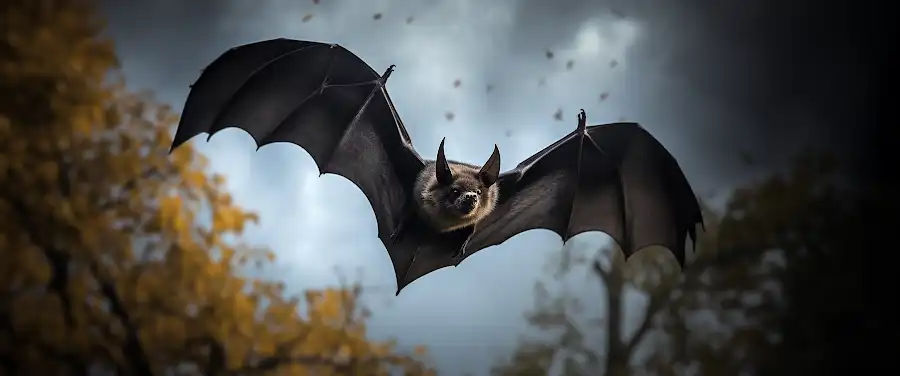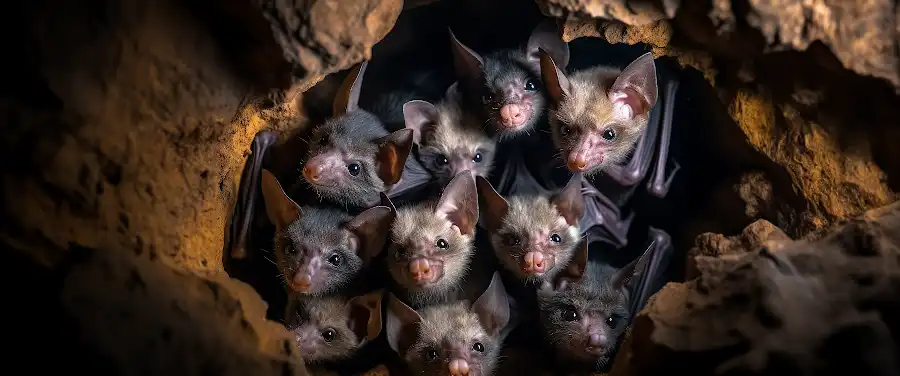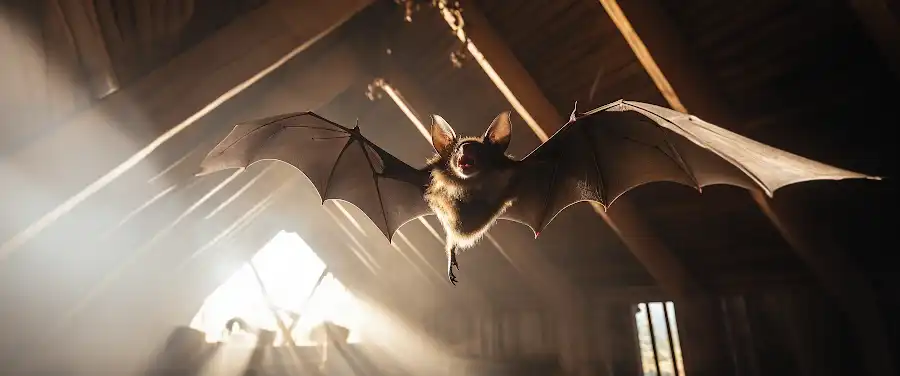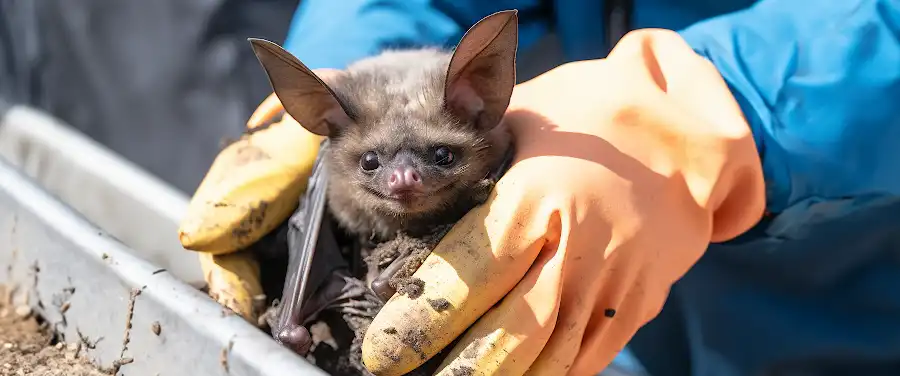
Have you ever walked into an old, decrepit building only to be startled by the fluttering of wings and the sudden rush of little shadows screaming past your face? Well, chances are what you encountered were bats. Plenty of them. In fact, you may have just stumbled upon a full-blown case of bat infestation. By the time this experience is over, you’d probably have more than just a few goosebumps – as the health risks associated with bats could really raise the hair on the back of your neck.
Investigating deeper, you’ll probably easily come across the outré, almost cinematic tales of vampires and dark, foreboding nights related to bats. But beyond the visually intriguing, it’s the invisible, inherent dangers associated with a bat infestation that truly sets one’s nerves on edge. The silent and unseen hazards that could be lingering unnoticed in your home or workspace. This isn’t just about bats being a nuisance – it’s about the delicate balance of wellness put in jeopardy by bat infestations.
So, while Batman might be a crowd favorite, actual bats don’t really bask in the same celebrity spotlight. Many folks consider bats as bothersome, and it’s not without reason. Stay with us as we saddle up and journey through the shadowy recesses of bat infestations, learning about the well-cloaked risks they carry along. Keep your eyes peeled and your ears tuned – the next flutter you hear might just be a warning of lurking threats. The world of bats is much more than a mere nuisance; it’s a fascinating narrative of survival, interspecies interactions, and the unforeseen impacts on human health these tiny creatures can have. Now, let’s answer an important question: What are bats and why are they truly a nuisance?
How Can You Identify a Bat Infestation?

Bats can be fascinating creatures when they’re out in the wild, but the story changes when they decide to set up residence in our living spaces. Identifying bat infestations early is key to preventing possible health hazards and structural damage to your property.
To identify a bat infestation, observe for common bat signs such as unusual noises, guano (bat droppings), urine stains on walls or floors, and of course, frequent bat sightings. If you’re hearing mysterious scratching or squeaking sounds from your attic or walls, or notice dark, small droppings in and around your property, chances are you have a bat problem.
However, the mere presence of bats doesn’t necessarily imply infestation. Bats can occasionally fly into homes through open windows or doors and may not represent a colony. A true infestation involves a bat colony making home in part of your residence, like the attic or walls.
What Are The Physical Signs of a Bat Infestation?
Bat infestations come with physical signs that are hard to miss once you know what to look for. Of course, seeing a bat in your living space is a clear indicator. But, remember, bats are nocturnal animals, meaning they’re more active at night.
A surer sign of infestation would be bat droppings or guano. Guano is a significant health hazard and can accumulate quickly, creating a foul smell and even causing structural damage over time. Bat urine can also leave behind stains that are difficult to clean. Plus, listen out for bat noises, such as high-pitched chirps, particularly at dusk or dawn, when bats are most active.
Early detection is crucial to minimize impact on your household’s health and safety. Getting professional help can further simplify this process.
What Are The Physical Signs of a Bat Infestation?
When it comes to combatting bat infestations, a DIY approach may not be the best idea. Professional pest controllers have the necessary expertise and use sophisticated bat detection technology to ensure a thorough and safe solution.
Professionals have access to ultrasonic devices, thermal imaging cameras, and other high-tech tools for identifying and removing bats, guaranteeing a swift and thorough result. Their expertise allows them to undertake the task responsibly, ensuring bats are removed without unnecessary harm and that future infestations are prevented.
Now that we know how to identify and address bat infestations, it’s time to delve into a notably serious aspect – the health risks associated with bat infestations.
How Can Professionals Help in Detecting Bat Infestations?
When it comes to combatting bat infestations, a DIY approach may not be the best idea. Professional pest controllers have the necessary expertise and use sophisticated bat detection technology to ensure a thorough and safe solution.
Professionals have access to ultrasonic devices, thermal imaging cameras, and other high-tech tools for identifying and removing bats, guaranteeing a swift and thorough result. Their expertise allows them to undertake the task responsibly, ensuring bats are removed without unnecessary harm and that future infestations are prevented.
Now that we know how to identify and address bat infestations, it’s time to delve into a notably serious aspect – the health risks associated with bat infestations.
What Health Risks are Associated with Bat Infestations?

Bat infestations can pose significant health risks for humans. It’s essential to familiarize yourself with these potential dangers should you find the dark-winged creatures in your home. While bats play a vital role in our ecosystem, certain risks come with sharing space with them, especially diseases directly transmitted from bats to humans.
One of the major health risks associated with bats is a group of viruses known as zoonotic diseases. These diseases, including Rabies and SARS-like coronaviruses, can be transmitted to humans if they come into contact with an infected bat, usually through bites or scratches.
Furthermore, bat infestations can bring about some indirect health risks. Sometimes, it’s not the bats themselves that make us ill – but their tiny uninvited house guests. Yes, we’re talking about parasites, such as ticks and mites that bats host. These tiny creatures might carry diseases such as Lyme Disease or Colorado Tick Fever.
Next, we have a hazard that is unique to bats – their droppings, also known as guano. The droppings of bats can lead to a potentially fatal lung disease called Histoplasmosis. If airborne spores from bat guano are inhaled, it can lead to severe respiratory issues.
Do Certain Bat Species Pose More Health Risks than Others?
Now, when we consider bat species, it’s worth mentioning that not all bats pose equal risks. Different bat species have different disease-transmitting potential.
Although the risk of disease transmission can increase based on the bat species in your vicinity, situations such as direct contact, a bat bite or exposure to bat droppings also amplify the risk.
Many people fear bats because they believe all are virus reservoirs, even the “cute” ones. However, it’s important to debunk this fear by emphasizing that not all bats carry diseases, and disease transmission is quite rare if you don’t have direct contact with them.
Although the risk of disease transmission can increase based on the bat species in your vicinity, situations such as direct contact, a bat bite or exposure to bat droppings also amplify the risk.
Many people fear bats because they believe all are virus reservoirs, even the “cute” ones. However, it’s important to debunk this fear by emphasizing that not all bats carry diseases, and disease transmission is quite rare if you don’t have direct contact with them.
So, now that you understand the invisible enemies we might harbor due to bat infestations, let’s examine another, more visible type of damage caused by bats – particularly, the impact of their droppings on our built environment. Stay with me as we delve into “How do Bat Droppings Damage Buildings?“.
How do Bat Droppings Damage Buildings?

Bats are integral to our environment, they control pest insects, pollinate plants, and scatter seeds. Nevertheless, when they decide to occupy places where they’re unwelcome, like our homes and workplaces, they can become a real problem. But why? Mainly, the damage isn’t caused by the bats themselves but by their droppings, also known as bat guano.
Firstly, bat guano is known for its strong, unpleasant odor. While an occasional bat in the attic is no cause for alarm, a bat colony leaving behind their waste definitely is. The smell caused by droppings and urine, especially in large amounts, can make living or working in affected buildings uncomfortable, even untenable.
But it’s not just about the noxious smell – cleanup problems associated with bat guano can be quite challenging too. Guano tends to accumulate, and removing it isn’t as simple as sweeping it up. The process involves protective equipment and specialized cleaning agents, often requiring professional intervention.
Furthermore, one might be astonished to find out that bat urine can actually cause structural damage to buildings. How? Over time, the acidic properties of urine corrode various types of materials, potentially causing a weakening of structures. The droppings and urine can cause staining and even gradual rot on surfaces like wood and drywall.
Undoubtedly, the consequences of a bat infestation can be severe – not just on the human psyche, but on our houses and buildings as well. In fact, in some cases, the damage could even result in substantial costs for building owners. To give you an idea, the cleanup of bat urine and guano in church structures in the U.S has cost up to $600,000, according to figures from NPS. Thus, understanding the potential issues caused by bat infestations is crucial in preventing such expenses.
In the end, while bats are pretty amazing creatures when in their proper habitats, when they start hanging up in our homes and workplaces, they can really mess things up. If you suspect bat infestation, it’s always a smart move to call in professionals who can safely and effectively remove their presence. Now that you understand why their droppings can be problematic, let’s move onto discussing “How to Prevent Bat Infestations?“.
Conclusion
In conclusion, it’s imperative to consider the hidden but significant health risks and potential property damage associations with bat infestations. However, these problems are not insurmountable. With the help of professional intervention, these uninvited gusts can typically be removed and prevented from returning to your space. Even so, preventative actions and early detection are your most reliable allies for ensuring a healthy, bat-free environment.
Remember, bats pose more than just a nightly nuisance. They can bring health challenges ranging from the transmission of diseases like rabies to the spread of fungal exposure caused by bat droppings, often referred to as guano. Moreover, these creatures can cause significant damage to your property over time and detract from overall house value.
However, don’t panic. Reach out to professionals who understand how to handle these creatures responsibly and humanely. They can provide you with the tools and knowledge to prevent future invasions. Think of it as an insurance policy, protecting your health and your investment in your home.
Taking action today can spare you from an array of avoidable issues tomorrow. Stay safe, stay informed, and remember, you’re not in this alone.




